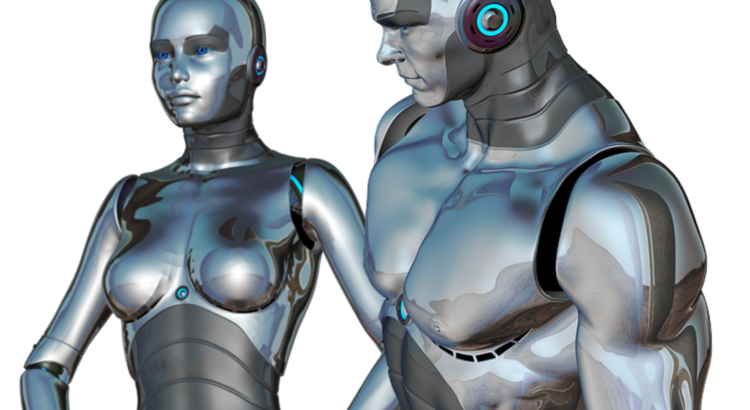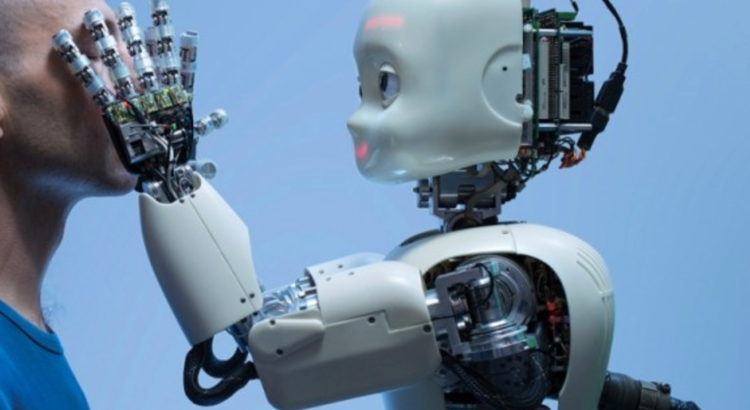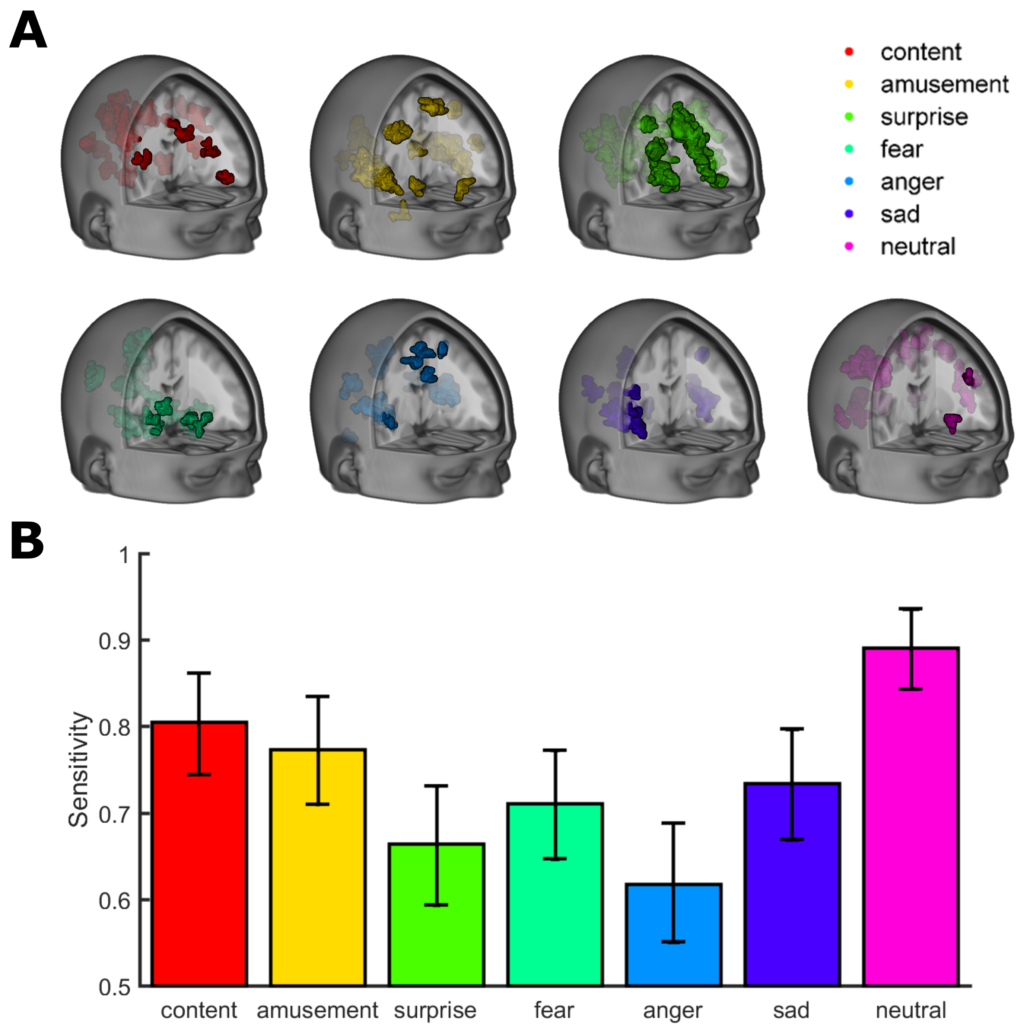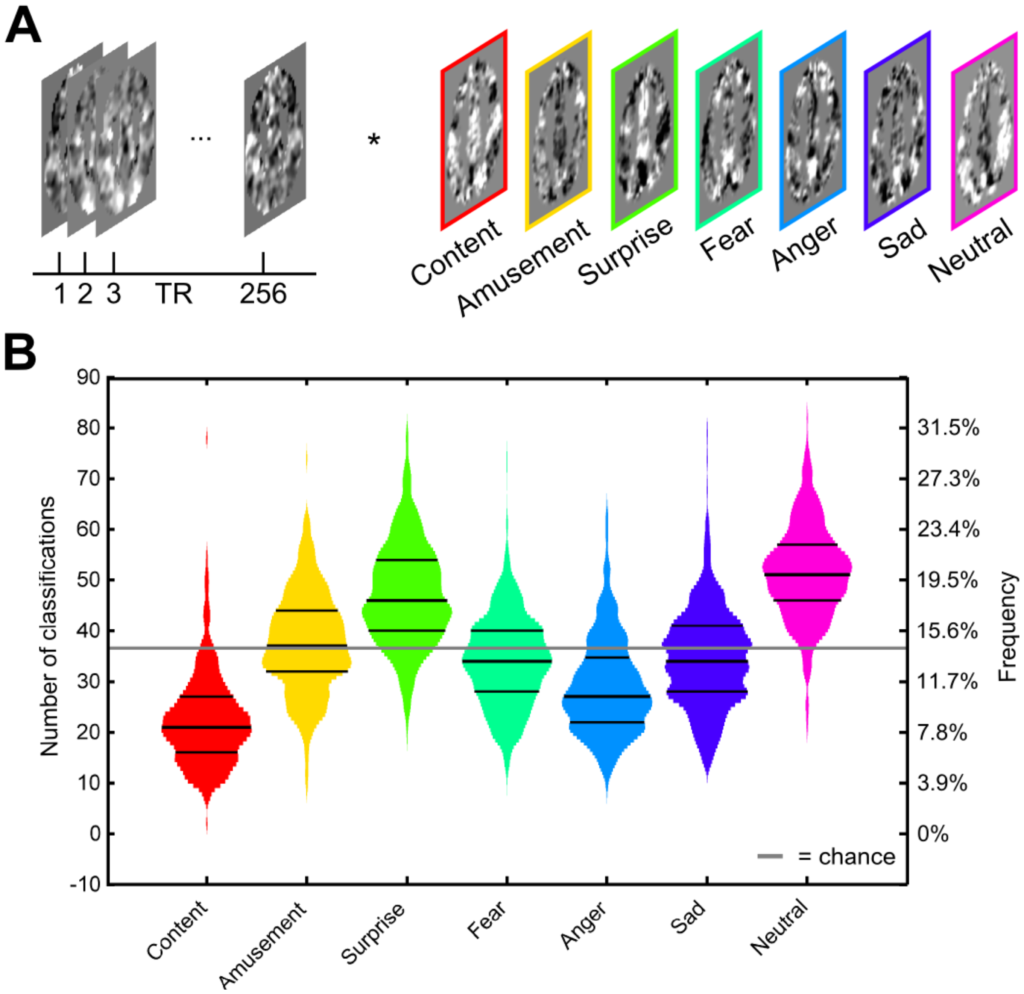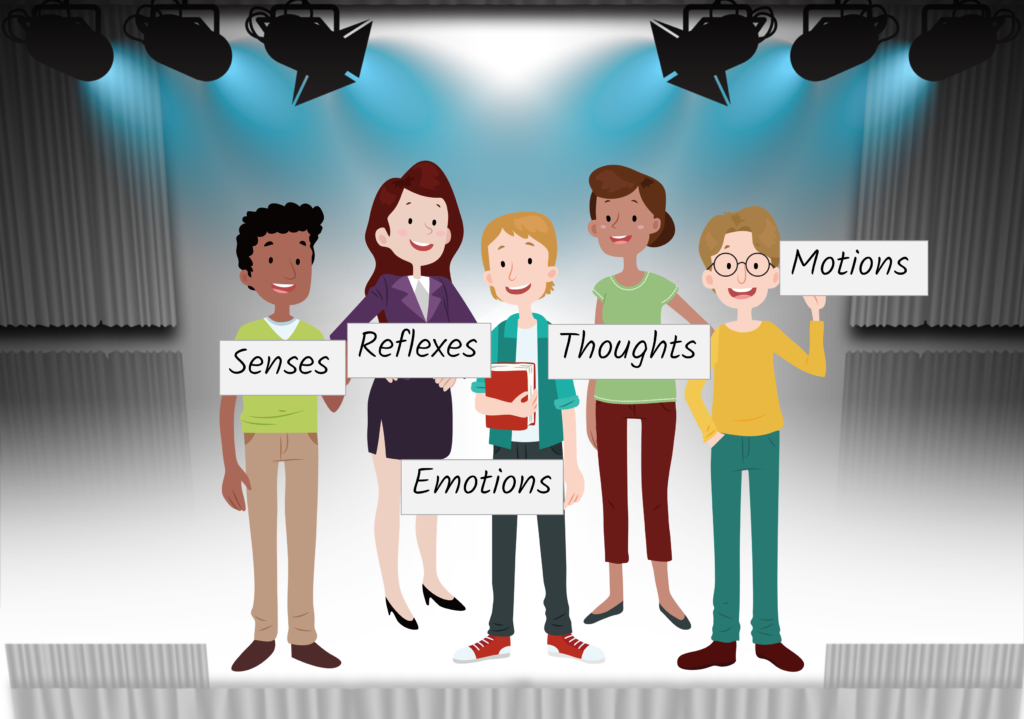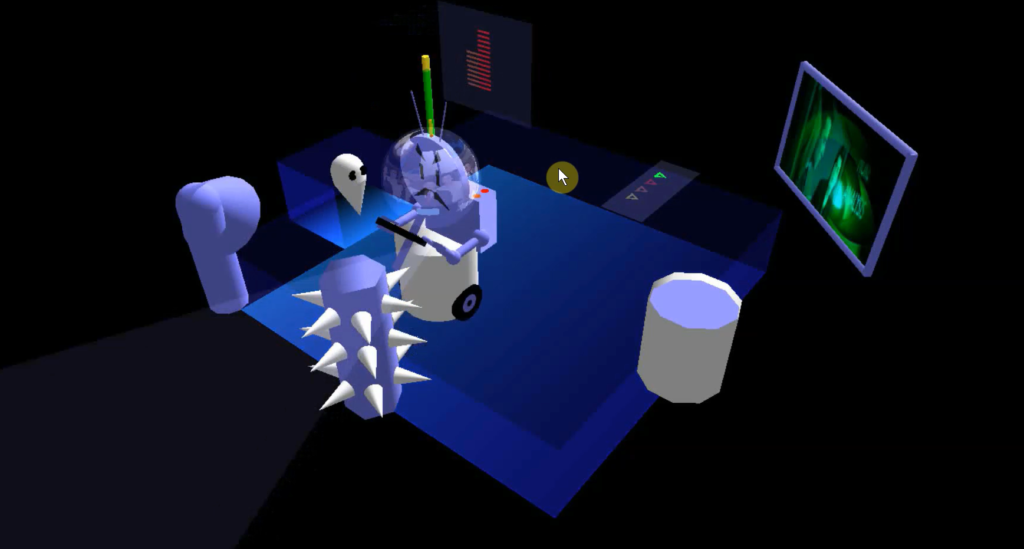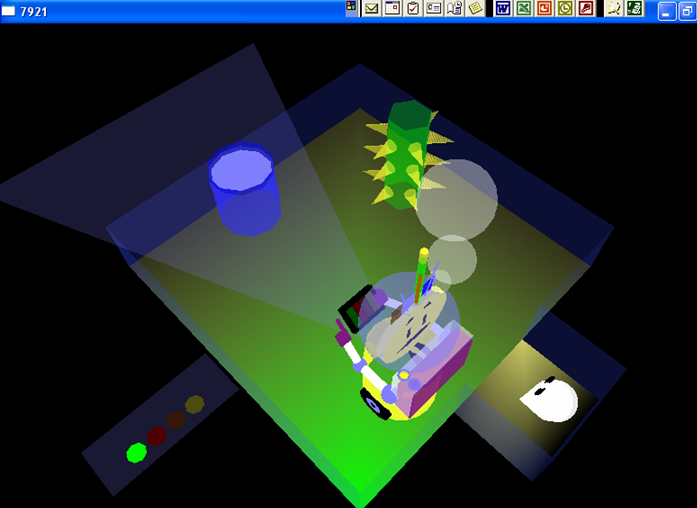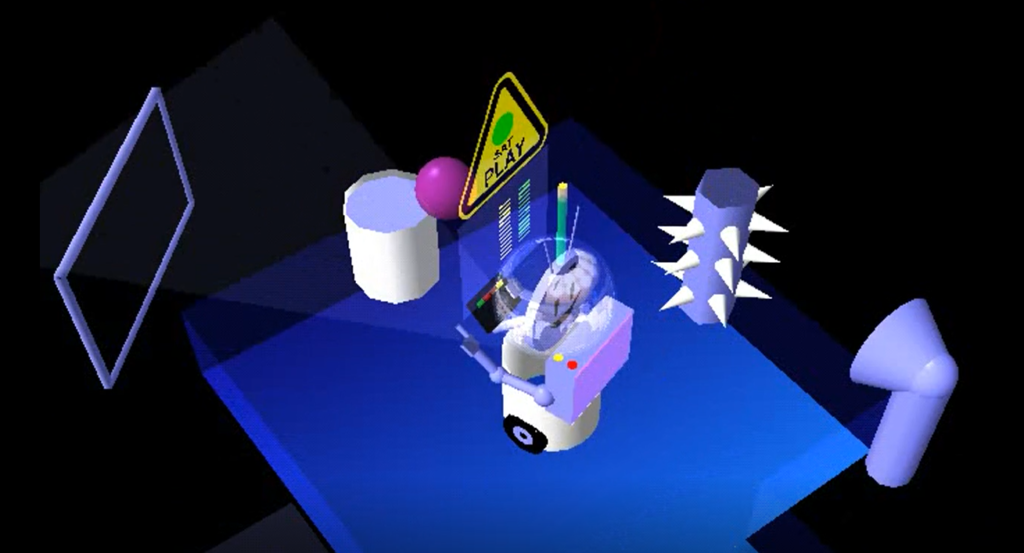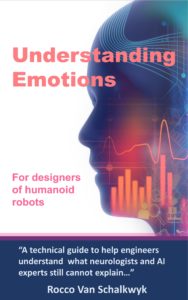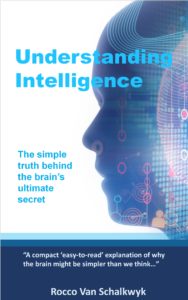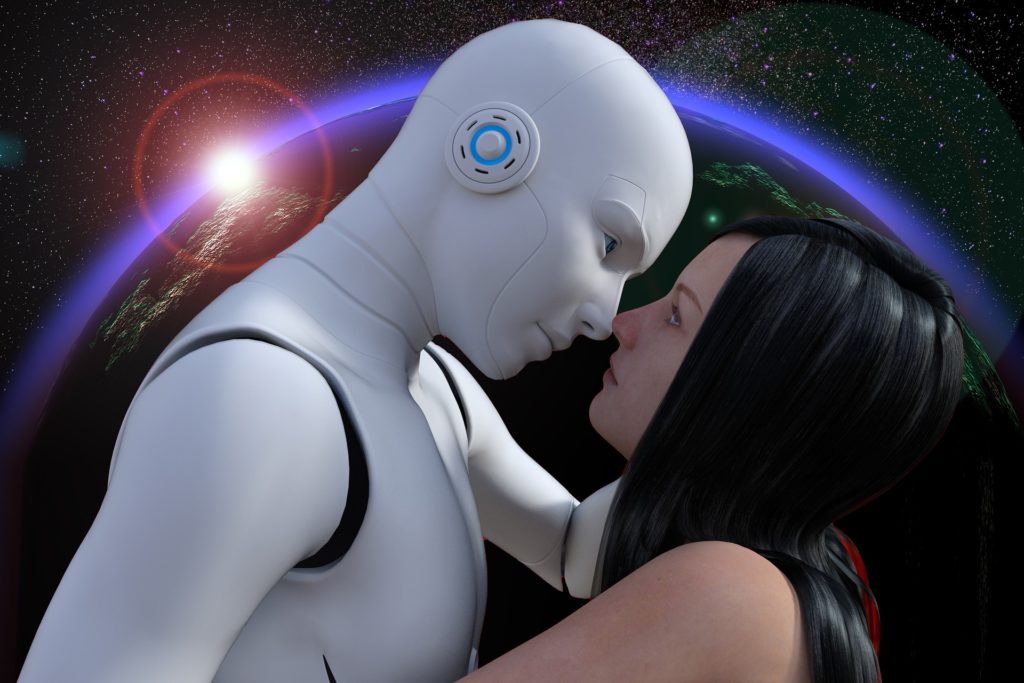Taking it to the next level…
If you told me 25 years ago that machines can have emotions – I would have been annoyed. I would have quietly written you off as a crank!
But now I build robots with emotions – and I want to show to you that, as farfetched as it might seem, there is a scientific basis for arguing that machines can have truly ‘subjective’ emotions.
In this day and age of lamenting the slow progress of Artificial Intelligence and with some people wondering if we are ever going to understand the brain – not many researchers are aware of the existence of a simple brain model that offers a ‘principal’ explanation of all that happens in the brain.
It is called the Xzistor Concept.
Not only does it explain many of the obscure phenomena about the brain that some think can only fit into a nebulous definition of ‘consciousness’ or ‘subjective experience’ – but it actually explains everything in mathematics.
This means that its simple functions can be coded into simulations and robotic applications to show how the behaviors we see in humans can be generated in machines. Many has decided this model is too simple to reveal all that happens in the brain, but some are now starting to put its careful choice of basic functions under the spotlight, and discovering how difficult it is to refute its simple basis. They are starting to believe that in fact its simple functions could over time generate all of the rich contexts and complexity by a process of perpetual learning. Some are now saying this model has solved Chalmers ‘hard problem’ and that there is principally no difference between the ‘subjective’ states experienced by an Xzistor robot and those experienced by humans.
The Xzistor Concept is a ‘functional’ brain model that requires no understanding of neural networks or brain biology and rests on two theoretical pillars – emotions and intelligence. It provides the functionality that explains how emotions tell the brain ‘what to do’, and it shows how intelligence tells the brain ‘how to do it’.
Interestingly, it shows that emotions are permanently and prominently involved in the creation of intelligence and that, in the absence of emotions, intelligence will collapse immediately. Pretty much what phycologists have been telling us for years!
The two theoretical approaches to emotion and intelligence used by the model are described in two simple guides available here:
Understanding Emotions
Understanding Intelligence
This post is aimed at providing a somewhat more detailed look at how the Xzistor Concept brain model explains not just ‘machine emotions’, but also ‘machine mood’. It is specially for those who have reached out to me and said that this model strikes a chord with their own understanding of the brain and now wants to know more about the Xzistor Concept. Specifically, I want to provide a clear explanation of how truly ‘subjective’ machine emotions can be generated and also how the model explains the presence of an omni-present machine ‘mood’ that will, just like in humans, persist beyond the normal undulations of happiness and sadness based on daily needs, anxieties, frustrations and desires for pleasure.
Let’s start off exactly in the same place as the model would when building an artificial brain – with homeostasis. Whilst the mechanism of homeostasis as a control concept in the brain has been around for hundreds of years, what has been missing is how homeostasis states can be turned into truly ‘subjective’ emotions and how these emotions can drive decision-making, intuition and determine our daily mood.
Everything the Xzistor Concept artificial brain will drive the intelligent agent (robot) to do, will start off with homeostasis. We will see homeostasis forms the motivation for everything the brain needs to do from maintaining metabolism (surviving), staying uninjured (healthy) and performing the actions required for reproduction.
The model begins by identifying utility parameters it will measure and assess to base homeostasis mechanisms on. Some of these utility parameters will be relevant to a living biological organism e.g. carbohydrate / glucose level in the blood (hunger), water in the blood (thirst), oxygen level in the blood (breathing), bladder pressure (urination), colon pressure (defecation), body internal cold temperature (seek heat), body internal hot temperature (seek cold), muscle fatigue marker in blood (rest), sleep drug level in blood (sleeping), toxin level in blood (nausea), pain receptors (pain), adrenaline in blood (anxiety), etc. Some of these homeostasis mechanisms will be built up out of many mini-homeostasis mechanisms e.g. hunger could comprise mini-homeostasis mechanisms for sweet, salt, sour, bitter, warm tongue, cold tongue, warm throat, cold throat, chilli burn, umami, etc. This can even extend to esophagus tactile pressure and saliva acridity mechanisms. This is how we can differentiate between different tastes, like garlic and chocolate, and how they can be pleasant in their own unique ways. In this way we can experience cravings for very specific substances depending on the different chemical deficit / restore balancing acts going on in the body related to hunger.
For intelligent agents (robots) we can choose any utility parameter we deem necessary for the robot to operate in a manner we want it to operate. Whereas food and water might not be relevant, we can now choose battery level of charge instead of food to tell the robot to maintain this parameter in homeostasis. Many of the utility parameters used for humans (and other organisms) can be transferred in some way to our choice of utility parameters we want to use for a robot. We can use pressure receptors (sensors) to make the robot experience pain, we can make the robot experience fatigue by using motor power as opposed to muscle fatigue markers in the blood, control of hot internal temperatures, control of cold internal temperatures, etc. etc.
Although most proponents of homeostasis as the basis of emotions, will be quite comfortable with what has been stated above – there is often a level of confusion that enters at this point. This has to do with the fact that many brain researchers feel a homeostasis mechanism can only be based on an innate physical (biological) utility parameter which is measurable, something like oxygen level in the blood or body core temperature. This unfortunately often leads to important omissions. Let’s take a look at the sex drive for instance. Looking past the intricacies of the sex drive mechanism in the human mind and the myriad of hormonal effects that underpin it, we can say the sex drive is activated by a visual stimulation like an optical observation of a person that has physical attributes e.g. either sexy or handsome. This might be an oversimplification, but the point here is that what triggers homeostasis to move to a position where it needs to be restored or corrected is actually an optical state (visual image). By simply looking at an attractive person, we start to experience a sexual tension and nature’s aim is for us to act on this frustration (eventually) and ‘satisfy’ it. It often works the same for the aggression drive – where a visual que e.g. observing an enemy, will generate a heightened or aroused state that can only be satisfied by an outburst or physical altercation. There is an important lesson here, namely that homeostasis mechanisms can make use of ‘any measurable entity’ – even a sensory state (or any brain state for that matter).
Soon we will see how even a mere ‘thought’ about something that has affected homeostasis in the past, can generate emotions in the mind. Here is a simple example in humans: Let’s say we have bumped into a cactus in the garden and received a painful sting from its thorns while trying to pick an apple. We have remembered the encounter and now when we recall it, the negative emotion that was attached to the association will also be re-evoked. This means we will again ‘feel’ the emotion – not the actual pain, but the negative emotion that accompanied the pain. We will soon see exactly how this works, but we can call this the ‘fear of pain’. And this ‘thought’-triggered emotion will effectively act as a homeostasis mechanism that will compete with other homeostasis mechanisms to gain the attention of the brain.
For instance, the hunger homeostasis might be very strong, but the ‘fear of pain’ homeostasis mechanism might even be stronger at a given moment and make us ‘too fearful’ to reach past the thorns of the cactus to get the apple.
It is important to keep in mind that homeostasis mechanisms can be based on biological parameters, physical parameters, visual states or even brain states saved as part of associations (e.g. emotions linked to our memories). When we design virtual Xzistor robots these utility parameters are all simulated, but the virtual agent never realises this.
But let’s be clear on how these homeostasis mechanisms create states that can be used to base real ‘subjective’ emotions on because there is another mistake many brain researchers make at this juncture. We must not at this stage mistake ‘later life’ effects that will follow from learning over time, with homeostasis mechanisms. People might suggest that because a species show ‘social’ tendencies they have homeostasis mechanisms driving social needs such as social standing, companionship, family-ties, admiration, collaboration, love and acceptance. But these are learned behaviors that will depend on the environment the humans grow up in and although all human behaviors are driven by homeostasis mechanisms, these are not innate homeostasis mechanisms in themselves. A good test to perform is to ask if evidence can be found of these mechanisms being present at birth – in most cases if such evidence is not apparent, it can be assumed the behavior is learnt later in life. Similarly, the drive to explore and expand one’s knowledge comes only after having learnt how helpful it is to understand your environment better (e.g. to avoid threats, frustrations and missed opportunities all related to homeostasis drives). Infantile curiosity is already present at birth as a (dumb) reflex but it is not a homeostasis mechanism, and later life curiosity is all about the advantages that environmental information can bring – a fact that we become aware of as we go through life. It helps us solve homeostasis deficits, but is not a homeostasis mechanism in itself.
So again the caution – do not look for specialist innate mechanisms that provide the refined later life functions and effects, because the Xzistor Concept only uses simple functions already evident at birth and allow these to, based on extensive learning, create all the rich and complex effects.
Now that we are clear on how just about any measurable state in the brain can be used to base a homeostasis mechanism on, let’s take a look at the logical step by step process the Xzistor Concept follows to get to fully ‘subjective’ emotions.
Once the utility parameter has been identified it gets cast into a utility function. This defines the range of the utility parameter that will be important to the brain. We can take the utility parameter oxygen in the blood and plot it as a linear line on a graph. We can choose to only consider the oxygen utility parameter over the range 70% oxygen in the blood to 100% oxygen in the blood. We assume at around 100% oxygen in the blood the human will be perfectly fine and operating normally, whilst at 70% oxygen in the blood the human will actually die. We now need to tell the brain how serious it needs to be taking this reading.
When the oxygen in the blood reading is around 100% we do not need to inform the brain to prioritize breathing over other actions like finding food and water, but if an adversary starts choking us and our blood oxygen level drops to near 70%, we need to tell the brain to forget about food and water and urgently prioritize breathing. This is needed to restore the oxygen level that are now dangerously low and threatening our lives. These utility functions become meaningful to the brain when we start to plot the Urgency To Restore value (as a %) on the Y-axis versus the utility parameter value on the X-axis. This Urgency To Restore (UTR) function now tells the brain e.g. if the blood oxygen level is 100%, the Urgency To Restore is 0%, whilst when blood oxygen level is 70%, the Urgency To Restore is 100%.
This allows for the brain to not just exercise homeostasis of the utility parameters, but enables the brain to – at any given moment in time – compare all UTRs of all the utility parameters (as a % value) and identify the ‘most urgent’ utility parameter to focus its attention on.
We must not think that the mechanism above will be adequate to provide any sense of subjective emotions. To understand how subjective emotions are generated we need to delve a little deeper. The mechanisms above will process information taking the status of utility parameters and generating Urgency To Restore values as %, but the brain will be largely oblivious (unconscious) of this information processing. The brain does not have the time to ponder these measurements, calculations and comparisons and really just need the BOTTOM LINE to be communicated to it so that it can take the most appropriate action.
The brain has found a very clever way to do this.
It has gone to that area in the brain where our tactile senses are constantly being reported (also known as the somatosensory cortex or body map area of the brain) and ‘annexed’ two areas for its own personal use. Its aim with these two areas is not to create representations of tactile sensory states, but to instead create states that will represent the status of the UTRs. Because the brain is constantly ‘aware’ of tactile senses (just like other senses), we know this area will get constant scrutiny by the brain when it determines what behaviour to perform next. The brain will use one area, representing the ‘intra-abdominal’ or ‘gut’ area of the somatosensory cortex, to generate a representation – akin to a tactile state – but based on the UTRs that are signalling that they are out of homeostats (i.e. they need to be restored). We will say these UTRs are in Deprivation and we will call this ‘fake’ representational state a pseudo-tactile state. So, for instance, when the hunger level is high, we want to signal to the brain a general warning – as a ‘feeling’ – that we have entered a state we want to avoid. This ‘intra-abdominal’ pseudo-tactile state will do exactly that, because of the way the brain will give it an ‘avoidance value’.
How does the brain achieve this?
Simple.
As we discover the actions that lead us to eat when we are hungry (sometimes we are taught by a tutor), the brain teaches us that it were in fact these actions that led us away from the ‘intra-abdominal’ pseudo-tactile state created by the hunger UTR that went into Deprivation. The brain therefore rewards us for moving away from the ‘intra-abdominal’ pseudo-tactile state and solving the hunger problem.
These actions thus become strongly reinforced and next time we feel hungry and experience this ‘intra-abdominal’ pseudo-tactile state at the pit of our stomach, the brain automatically chooses and encourages us to use learned actions to make the state go away. In this way we learn that this is a state that we want to ‘avoid’ whenever we can – and we learn to call it ‘not good’ or a ‘bad feeling’.
The brain creates in exactly the same fashion a ‘positive’ pseudo-tactile state in the ‘intra-trunk’ area of the somatosensory cortex which we will learn to pursue – because in this case the brain will also encourage (reinforce) those actions restoring the homeostasis drive. We say the UTR has gone into Satiation. For instance, as we eat food, the homeostasis mechanism for hunger will record an ‘improvement’ or ‘restoration’ towards a balanced state – and all the actions we have been performing to make this happen, will become strongly reinforced by the brain.
Something very significant has now happened.
The brain has now started to attach an ‘avoidance’ context to the ‘intra-abdominal’ pseudo-tactile state – meaning the brain ‘does not like’ being in this condition since it generates a bad subjective state and all the brain has ever learnt is to avoid this ‘feeling’.
At the same time, the brain has started to attach a ‘pursual’ context to the ‘intra-trunk’ pseudo-tactile state – meaning the brain ‘very much likes’ being in this condition since it generates a good subjective state and all the brain has ever learnt is to pursue this ‘feeling’.
This explains how a ‘feeling’ in the gut area can develop that will steer us away from things that are not good for us, and how a ‘feeling’ in the chest area can develop that will steer us towards things that are good for us. In time we will learn to call the chest sensation ‘good’ and the gut sensation ‘bad’.
And these sensations are of course our ‘subjective’ emotions.
Simplified here, they will have nuanced aspects – like hunger might have mini-avoidance states in the mouth, tongue throat area (sweet, sour, salt, bitter, etc.) and pain might have bodily focus areas where the pain is experienced, but what is important is that these two ‘broad’ emotional states, one positive and one negative, are subjectively experienced and very much shared by all UTRs. So, now the brain achieves its goal of having a very fast single subjective ‘feeling’ to sway actions very quickly towards ‘avoidance’ or ‘pursual’. And we understand how emotions are created! This also explains how ‘intuition’ or ‘gut feel’ works and how we sometimes jump to conclusions even before we have thought things through properly.
Another caution: Just because the biological brain has chosen to package our emotions into pseudo-tactile representations, does not mean all emotions must be generated in the somatosensory area of the brain e.g for intelligent agents (robots). The only requirement from a logical perspective is that the states representing the Deprivation or Satiation of the UTRs will be constantly scrutinised by the brain and in real-time used to influence/decide behaviour. If we make these emotions appear to be originating in the gut or chest area, it does of course make us feel like these emotions are inside our bodies and that we are the owners of these feelings. Interestingly, if we as human can move our emotions out of the somatosensory area of the brain, we might stop saying we ‘feel’ good or we ‘feel’ bad. Instead we will just be aware that we are in a good state or in a bad state, and might rather say ‘I know I am good!’ or ‘I know I am bad!’.
Now let’s see what happens when we attach these emotional states to memories.
Since we say an association is nothing other than just a snapshot of things (brain states) that were present in the brain at a given moment in time e.g. what was seen, what was smelled, what was heard, what was done, etc. – we can just link the emotion to these. Because we constantly have the utility parameters being kept at homeostasis driving their individual UTRs, which in turn drives the + and – emotions in the brain, every single one of our experiences will have a net emotion present when it happens that we can attach to that association.
This allows us to rank associations in future in order of importance – based on how strong the emotion (good or bad) was at the time, how often this association has been found to be relevant to solving problems and when last we used the association to solve a problem. We multiply these to create an ‘Impact Factor’ for every association.
As the brain spontaneously Threads through associations – either just daydreaming or trying to generate context and solve problems – we can use this Impact Factor to make sure we prioritize the most helpful associations in our everyday activities.
What happens when we recall associations and in the process re-evoke the emotions that had been stored as part of the association?
Well, we will ‘feel’ these emotions again as if they are part of our bodies – ‘good’ in the intra-trunk area and ‘bad’ in the intra-abdominal area.
But we must remember that at the same time, the UTRs will also be generating emotions based on their ‘utility parameter’ homeostasis mechanisms.
It therefore becomes important for the brain to ‘merge’ or ‘combine’ the emotions generated by UTRs and the ones re-evoked from associations.
We can now have a situation where a UTR is in Satiation, say we are eating food, and it will generate a positive emotion, but we can at the same time be recalling an accident we had witnessed a year ago where someone was seriously injured. The Xzistor Concept will combine these emotions – since they are now in a ‘common currency’ – and create a net emotion. This might result in a lack of appetite or even a feeling of nausea while at the same time our body is actually trying to tell us that we are also hungry.
In this way our net everyday emotions are created by combining both the utility-parameter based UTRs (we can call them Body UTRs) and the association recalled emotions (we can call them Brain UTRs).
As we learn to efficiently address our Body UTRs on a daily basis (eat, drink, stay warm, get coffee, avoid fatigue, etc.), our emotions get dominated by what we ‘think’ about – and as we learn what makes us happy and sad, we try to look ahead into the future and solve problems before they occur. A lot of negativity is generated when we think about what life is throwing at us as we desperately try to solve our Body UTRs – the fact that we have to work for money, the people that are obstructing us, the cost of living, crime risks, threats of war, the risk of health problems, harm to our loved ones, etc. This can create a thought pattern that is driven by ‘fear’ and negative emotion. It’s all about not being sure that we can Satiate all our UTRs now and in future. This perpetual fear about all that can prevent us from Satiating our UTRs in life – all that can go wrong basically – means that we are often in a permanent state of stress.
This we can call our ‘mood’.
This mood can of course also be positive when we have successfully secured ways to access Satiation – money, friends, power, assets, lifestyle, etc. but although we can be followed around by a perpetual feeling of success and Satiation in our lives, we often tend to start thinking about all that can go wrong again. As the brain evolved over thousands of years, it favored survival of those that tried to predict threats and worry about things before they happened – so natural selection has left us with a tendency to generate our own perpetual mental Deprivation – and often this can lead to ‘depression’.
There is no reason to believe this can only happen in humans!
In fact, it should now become clear how truly ‘subjective’ emotions can be generated within an artificial brain and how ‘positive’ or ‘negative’ moods can be experienced by machines just like humans.
Machine emotions are real – and they are here!
TOWARDS IMPLEMENTATION
For those interested in how the above theoretical approach was more closely modeled on the human brain and moved towards a robotic implementation, here is an ‘interim’ document that expands the above conceptual description towards implementation.
And for those who would like to work towards their own Xzistor robotic implementation, here is a very basic presentation to show how such an Xzistor implementation, with artificial emotions (and Thinking and Problem Solving) will work.




